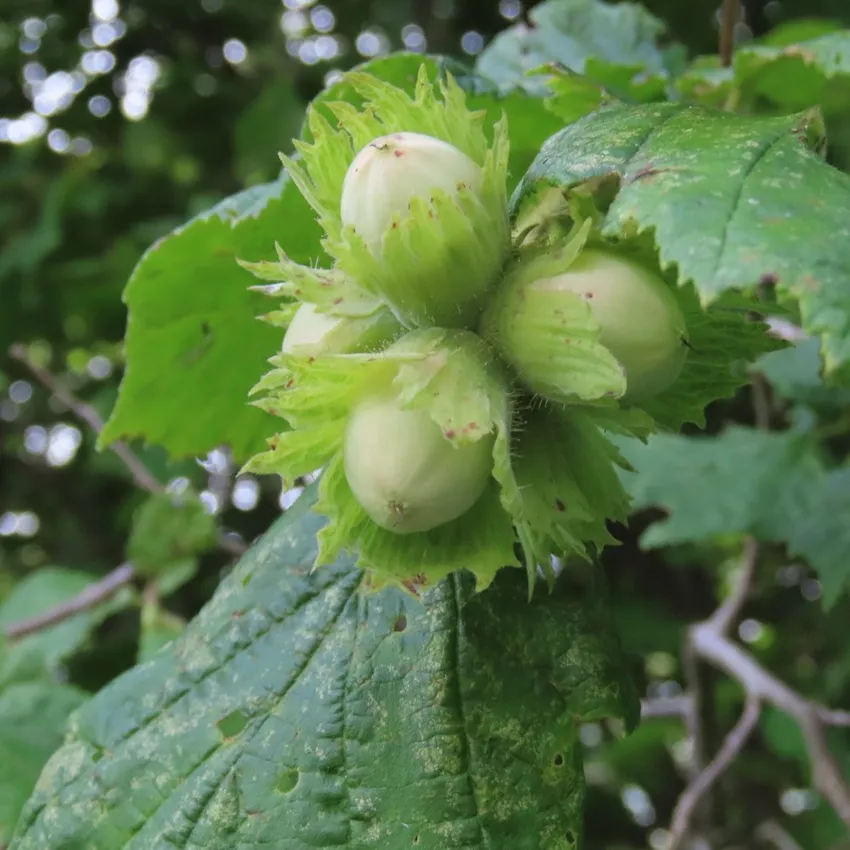The tree hazel is quite uncomplicated. Nevertheless, you should consider a few things when cultivating in your home garden.
 The tree hazel (Corylus colurna) became native to our latitudes as early as the 17th century. The plants are usually found in parks or used to stabilize slopes. In larger gardens, the Turkish hazel, which grows upright and can reach a height of up to 20 metres, is an attractive source of shade. The trees are easy to care for, impress with a pretty golden-yellow leaf color in autumn and bear edible fruit reminiscent of the native hazelnut.
The tree hazel (Corylus colurna) became native to our latitudes as early as the 17th century. The plants are usually found in parks or used to stabilize slopes. In larger gardens, the Turkish hazel, which grows upright and can reach a height of up to 20 metres, is an attractive source of shade. The trees are easy to care for, impress with a pretty golden-yellow leaf color in autumn and bear edible fruit reminiscent of the native hazelnut.
Origin and distribution of the tree hazel
The tree hazel's natural range is in the Balkans, in northern Turkey and in the Caucasus. There, the Turkish hazelnut prefers to grow on dry and nutrient-poor limestone soils. The temperatures in the original home fluctuate between five and twelve degrees, with an estimated annual rainfall of 650 millimeters. The robust plants tolerate temperature fluctuations between -38 and +40 degrees. As a result, the Byzantine hazel quickly became native throughout Europe.
The tree hazel is specifically cultivated in Germany, Italy, Hungary, Poland and Austria, but on a small scale. In most Central European countries, the use of the tree hazel is limited to gardening and landscaping. Overexploitation of the valuable wood led to a severe depletion of stocks in its natural range.
| Tree hazel (Corylus colurna) | |
|---|---|
| Growth Speed: | 20 - 35 cm a year |
| Growth: | 1,200 - 2,000 cm |
| Growth: | 800 - 1,200 cm |
| Root system: | Herzwurzler |
| Location: | Sun to partial shade |
| Floor: | deep, loamy, calcareous |
Use of Turkish Hazelnut
The wood of the tree hazel has an interesting grain consisting of a yellow-red sapwood and a red-brown core. The wood properties correspond approximately to sycamore maple. The wood is easy to work with and has been widely used in furniture making in the past.At that time, the tree hazel was also known as rosewood, an allusion to the reddish color of the wood.
The tree hazel forms nuts that are similar to the hazelnut, but significantly smaller. The edible fruits are often used to make confectionery. The contained oils are used in the pharmaceutical industry.
Location and Substrate for the Byzantine Hazel
The birch prefers a sunny site. In its natural distribution area, which extends from Asia Minor to south-eastern Europe, the tree hazel grows in sparse mixed forests and on stony slopes.
In the cities, the tree hazel can often be found in parks or also easily grows on roadsides. Only in shady and damp locations will the trees lag behind in their development because they lack the necessary sunlight.
The tree hazel makes few demands when it comes to the choice of substrate. The soil should be well drained. A humus rich soil is ideal. The tree hazel thrives well in sandy to loamy soil. A slightly acidic to strongly alkaline substrate is well tolerated.
Plant the tree hazel
 The tree hazel will not be easy to plant in every garden, because a stately tree of up to 20 meters in height will develop from the small seedling. The tree hazel needs enough space. There should be no buildings within a four to six meter radius. Also ensure adequate clearance from power lines and underground pipes.
The tree hazel will not be easy to plant in every garden, because a stately tree of up to 20 meters in height will develop from the small seedling. The tree hazel needs enough space. There should be no buildings within a four to six meter radius. Also ensure adequate clearance from power lines and underground pipes.
Cultivation is easily possible in a larger garden. The Turkish hazel grows particularly luxuriantly in the first few years. The growth height can increase by 35 centimeters and more every year. A hillside plot, for example, is a suitable location. The sprawling root network helps give the soil the necessary stability.
Before planting, prepare the soil accordingly. The months of February and March, as well as September and October are the best planting times. It is important that there is no ground frost on the day of planting.
Tip: Planted outside of the main growing season, the young trees can muster enough strength for the development of the root system.
Proceed as follows for planting:
- Dig the planting hole (at least twice the size of the root ball)
- Prepare the soil (mix with hummus, clay and some sand)
- Water the tree hazel (three to four hours in lukewarm water)
- Use tree hazel (untilupper root collar)
- Fill substrate
- Press the base firmly and avoid creating cavities
- Water hazel well
By adding pebbles, you can loosen and improve heavily compacted soil. This facilitates the drainage of rainwater and irrigation water. Water regularly for the first two weeks after planting. The soil must never dry out. The creation of a pouring edge has proven itself. For this purpose, the substrate is piled up in a cone shape with a diameter of about half a meter around the end of the tree. The tip is flattened. The watering edge is not planted.
Water the tree hazel correctly
 Watering the trees is a priority for young plants. Older plants have developed a widely branched root system, which enables them to be largely self-sufficient in water and nutrients.
Watering the trees is a priority for young plants. Older plants have developed a widely branched root system, which enables them to be largely self-sufficient in water and nutrients.
Tip: The tree hazel is considered a young plant up to the age of five years.
Young plants should be watered regularly on hot summer days. Daily watering is preferable to giving larger amounts of water. The earth must not dry out.
So that not too much liquid evaporates without being used, watering should preferably take place in the morning and evening hours. Covering the ground with brushwood or horn shavings can counteract evaporation. Regular mulching of the soil is beneficial. In winter it is not necessary to water the hazel tree.
Fertilize the tree hazel correctly
The tree hazel tolerates occasional fertilization. However, deciduous trees should not be supplied with commercially available liquid fertilizer. Far more suitable are organic fertilizers in the form of mature compost, horn shavings or lawn clippings.
Fertilizer can be applied in spring and late summer. From around mid-August, the tree hazel stops growing and prepares for hibernation. From this point on, no more fertilizer should be applied.
Tip: Mulching the soil around the plant in autumn ensures more ground heat and an economical and constant release of nutrients to the soil.
Pruning the tree hazel
The tree hazel does not tolerate pruning very well. Therefore, the plants cannot be used for hedge planting. Nevertheless, the hobby gardener does not have to do without saws and pruning shears entirely.
There are a few things to consider when cutting:
- Never cut branches down to the trunk (leave at least four inches)
- Provide interfaces with a special wound protection (especially in rainy weather)
- transverse branches should be removed
- Sick or dead branches should be cut out after winter
Tip: If young shoots were removed during pruning, you can use them as cuttings.
Propagating the tree hazel
The tree hazel is quite easy to propagate. Propagation by seeds or cuttings is possible. In addition to the necessary time, however, the hobby gardener also has to have a lot of patience.
Propagating tree hazel by seed - step by step

- Harvest Nuts
- Cover seeds with garden soil
- Keep substrate evenly moist
- Antifreeze necessary
The first shoot tips should appear in spring. It can be assumed that not every nut starts to sprout. Therefore, to be on the safe side, several seeds should be planted in the ground. When the young plants have reached a size of around 20 centimetres, they are separated and planted in the desired location.
Propagating tree hazel with cuttings - step by step
- choose slightly woody shoots
- Cut the shoot to a length of 30 centimeters
- Remove lower leaves and buds from cuttings
- Cover the cutting with potting soil (about two thirds)
- Moisten cuttings evenly
In spring and autumn you can cut and propagate cuttings from the tree hazel. Rooting can take place in the bed or in a sufficiently large plant pot.
Tip: If new buds and leaves appear, the propagation was successful.
Detect diseases and pests
Some pests that are often found in the garden are considered harmless to the robust tree hazel. These include aphids or spider mites. The small suckers cannot cause any lasting damage to the stately plants.
A targeted control of aphids is hardly possible due to the height of the tree. However, the hobby gardener can ensure that the habitat for assassin bugs, ladybugs and other natural predators is increased and optimized.
The biggest enemy of the tree hazel is the Verticillium wilt. The fungus affects the roots of Turkish hazel. The secreted toxins spread and kill the plant within a few years. There are no effective antidotes.
To prevent the fungal spores from spreading to other plants, the completeCompletely remove the tree with its root system and the surrounding substrate and dispose of it properly.
Wintering the tree hazel
The mature tree hazel withstands severe frosts in the two-digit range without any problems. Even frost cannot damage the robust plants.
In the first few years, the Turkish hazel is more sensitive and the root area should be protected from frost with brushwood, leaves or compost. In harsh climatic regions, covering the lower part of the trunk with sacking has also proven its worth.